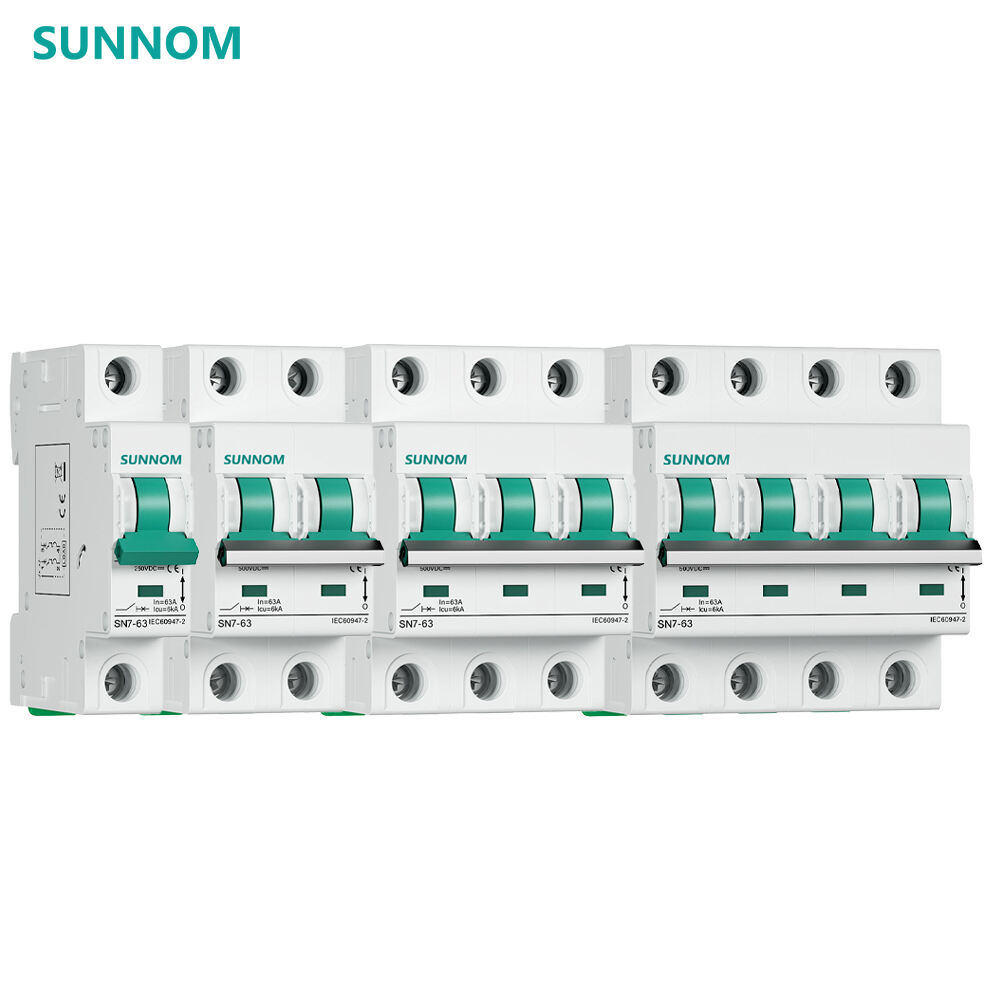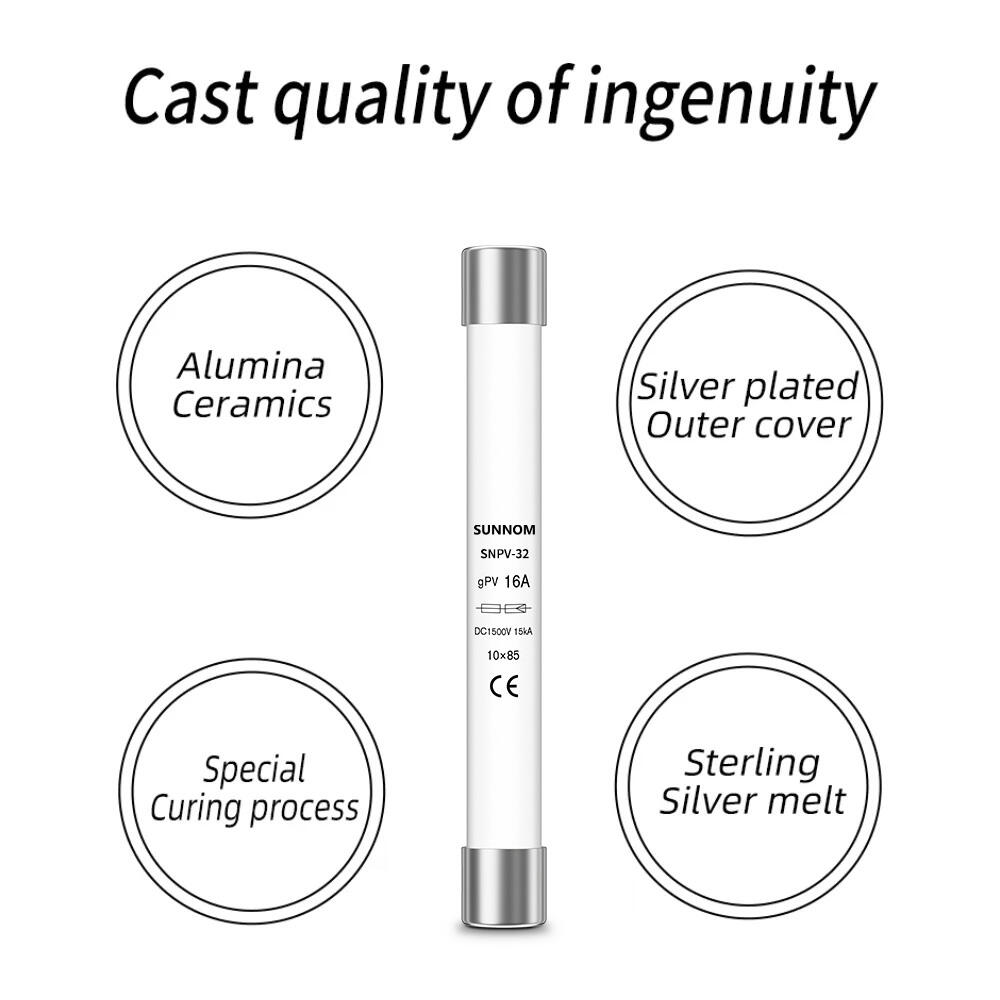Solar power systems have revolutionized renewable energy generation, but their efficient operation depends heavily on robust protection mechanisms. DC circuit breakers serve as the critical safety components that safeguard photovoltaic installations from electrical faults, overcurrent conditions, and potential fire hazards. These specialized protective devices are engineered specifically for direct current applications, offering superior performance compared to traditional AC breakers in solar environments. Understanding how these essential components function within solar installations helps system designers, installers, and operators make informed decisions about equipment selection and system configuration.

Understanding DC Circuit Breaker Technology in Solar Applications
Fundamental Operating Principles
DC circuit breakers operate on fundamentally different principles compared to their AC counterparts, primarily due to the continuous nature of direct current flow. Unlike alternating current that naturally crosses zero twice per cycle, direct current maintains constant polarity and magnitude, making arc extinction significantly more challenging. The breaker mechanism must forcibly interrupt the current flow by creating sufficient distance between contacts and employing arc suppression techniques. Modern DC breakers utilize magnetic blowout coils, vacuum chambers, or specialized arc-quenching materials to effectively eliminate electrical arcs during interruption events.
The contact system within DC breakers features specialized materials and geometries optimized for direct current switching. Silver-tungsten alloys or copper-tungsten compositions provide excellent conductivity while maintaining durability under repeated switching operations. The contact separation mechanism must achieve rapid opening speeds to minimize arc formation time, typically accomplished through spring-loaded or solenoid-actuated systems. Advanced breaker designs incorporate electronic trip units that provide precise current monitoring and programmable protection characteristics.
Arc suppression technology represents perhaps the most critical aspect of DC breaker design. Manufacturers employ various strategies including magnetic field manipulation, gas-filled chambers, and specialized arc-runner configurations. The magnetic blowout system uses permanent magnets or electromagnets to create magnetic fields that force the arc into designated extinction chambers. These chambers contain arc-splitting plates or grids that cool and deionize the arc plasma, effectively terminating the current flow.
Voltage and Current Ratings
Solar applications require DC breakers with specific voltage and current ratings matched to system parameters. Photovoltaic systems typically operate at voltages ranging from 12V in small residential applications to over 1000V in utility-scale installations. The breaker voltage rating must exceed the maximum system voltage by appropriate safety margins, typically 125% of the maximum expected voltage. Current ratings depend on the specific circuit protection requirements, with common ratings including 10A, 16A, 20A, 25A, 32A, 40A, 50A, and 63A for residential and commercial applications.
Breaking capacity represents another crucial specification, indicating the maximum fault current the breaker can safely interrupt. Solar installations may experience fault currents significantly higher than normal operating currents due to parallel string configurations and battery storage systems. High-quality DC circuit breakers feature breaking capacities ranging from 3kA to 10kA or higher, ensuring reliable protection under severe fault conditions. The prospective fault current calculations must consider all connected sources including solar panels, batteries, and grid-tie inverters.
Temperature derating factors significantly impact breaker performance in outdoor solar installations. Ambient temperatures exceeding standard rating conditions require current derating to maintain proper protection characteristics. Most manufacturers provide derating curves showing the relationship between ambient temperature and maximum allowable current. Installation environments with temperatures exceeding 40°C may require oversized breakers or enhanced cooling provisions to ensure proper operation.
Protection Functions in Solar Power Systems
Overcurrent Protection
Overcurrent protection represents the primary function of DC circuit breakers in solar installations, safeguarding conductors, equipment, and personnel from excessive current conditions. Solar panel strings can experience overcurrent situations due to ground faults, short circuits, or reverse current flow from other strings. The breaker's trip characteristic curve must coordinate with conductor ampacity ratings and equipment thermal limits to provide effective protection while avoiding nuisance tripping during normal operation.
Time-current characteristics of DC breakers differ significantly from AC devices due to the absence of natural current zero crossings. The trip curve shows the relationship between fault current magnitude and clearing time, with higher currents resulting in faster trip times. Instantaneous trip settings protect against severe faults, while time-delay characteristics prevent nuisance tripping during temporary overload conditions such as cloud edge effects or startup transients.
Ground fault protection integration within DC breakers provides enhanced safety in solar applications. Ground faults in DC systems pose particular risks due to the potential for sustained arcing and fire hazards. Advanced breakers incorporate ground fault detection circuits that monitor current imbalances between positive and negative conductors, triggering protective action when predetermined thresholds are exceeded. This functionality proves especially critical in rooftop installations where ground faults could initiate structure fires.
Arc Fault Protection
Arc fault protection has become increasingly important in solar installations following regulatory requirements and safety concerns. DC arc faults can occur due to loose connections, damaged conductors, or component degradation, creating sustained electrical arcs with temperatures exceeding 3000°C. These conditions pose significant fire risks, particularly in residential rooftop applications where detection and suppression capabilities may be limited.
Modern DC breakers incorporate sophisticated arc fault detection algorithms that analyze current and voltage waveforms for characteristic arc signatures. The detection circuitry employs digital signal processing techniques to distinguish between normal switching events and potentially dangerous arc conditions. Time-domain analysis examines current interruption patterns while frequency-domain analysis identifies the broadband noise characteristics typical of electrical arcs.
Integration of arc fault protection with conventional overcurrent protection creates comprehensive safety systems for solar installations. The combined functionality requires careful coordination to prevent conflicts between protection schemes while ensuring rapid response to genuine hazard conditions. Advanced breaker designs include communication capabilities that report arc fault events to system monitoring equipment, enabling proactive maintenance and hazard mitigation.
Installation and Configuration Considerations
System Architecture Integration
Proper integration of DC circuit breakers within solar system architecture requires careful consideration of protection coordination, accessibility, and maintenance requirements. Breakers typically install in combiner boxes, DC disconnect enclosures, or main distribution panels depending on system configuration and local code requirements. The protection scheme must provide selective coordination, ensuring that only the breaker closest to the fault operates while maintaining service to unaffected circuits.
String-level protection using individual breakers for each solar panel string offers maximum system availability and fault isolation capability. This configuration allows continued operation of healthy strings while isolating faulted circuits for maintenance. However, the increased component count and associated costs must be balanced against the improved reliability and diagnostic capabilities. Alternative approaches include group protection schemes where multiple strings share common breakers, reducing component costs while maintaining adequate protection levels.
Combiner box design significantly influences breaker selection and installation requirements. The enclosure must provide adequate clearances for breaker operation and maintenance while meeting environmental protection standards. Thermal management becomes critical in high-temperature environments where multiple breakers operate in close proximity. Proper ventilation, heat dissipation, and component spacing prevent thermal interference that could compromise protection performance.
Environmental Considerations
Solar installations expose DC breakers to challenging environmental conditions including temperature extremes, humidity, UV radiation, and corrosive atmospheres. Breaker selection must account for these factors through appropriate enclosure ratings, material specifications, and environmental certifications. Marine environments require special attention to corrosion resistance, while desert installations must withstand extreme temperature cycling and dust ingress.
Altitude effects become significant for installations above 2000 meters, where reduced air density affects arc extinction capability and cooling performance. High-altitude applications may require derating or specialized breaker designs to maintain proper protection characteristics. Similarly, extreme cold conditions can affect mechanical operation and trip characteristics, requiring cold-weather qualified components for reliable operation.
Seismic considerations influence breaker mounting and installation methods in earthquake-prone regions. Proper mechanical securing prevents damage during seismic events while maintaining electrical connections and protection functionality. Flexible connections and vibration-resistant mounting hardware help ensure continued operation following moderate seismic activity.
Maintenance and Performance Optimization
Preventive Maintenance Programs
Effective maintenance programs for DC circuit breakers in solar applications focus on preventing degradation that could compromise protection performance. Regular inspection schedules should include visual examination of breaker housings for signs of overheating, corrosion, or mechanical damage. Connection tightness verification prevents resistance heating that could lead to contact degradation or nuisance tripping. Thermal imaging surveys identify hot spots indicating loose connections or internal component degradation.
Contact resistance testing provides quantitative assessment of breaker condition and performance trends. Micro-ohmmeter measurements across closed contacts reveal increasing resistance that may indicate contact wear or contamination. Trending these measurements over time enables predictive maintenance strategies that replace components before failure occurs. Trip testing verifies proper operation of protection functions and calibration accuracy.
Environmental cleaning and protection maintenance becomes particularly important in dusty or corrosive environments. Regular cleaning of breaker exteriors and ventilation openings prevents heat buildup and ensures proper cooling. Corrosion protection measures including protective coatings and desiccant systems help extend service life in challenging environments. Proper torque verification of mounting hardware and electrical connections prevents loosening due to thermal cycling.
Performance Monitoring and Diagnostics
Advanced DC breakers increasingly incorporate diagnostic capabilities that enable condition monitoring and predictive maintenance. Built-in current transformers and voltage sensors provide real-time monitoring of electrical parameters including current magnitude, voltage levels, and power consumption. Data logging capabilities record operational history including trip events, load profiles, and environmental conditions.
Communication interfaces enable integration with system monitoring platforms for centralized data collection and analysis. Modbus, Ethernet, or wireless communication protocols transmit breaker status information to supervisory control systems. Alarm and notification features alert operators to abnormal conditions or impending maintenance requirements. Remote monitoring capabilities prove particularly valuable for distributed solar installations where physical access may be limited.
Trending analysis of operational data reveals patterns that indicate component aging, environmental stress, or operational anomalies. Machine learning algorithms can identify subtle changes in breaker behavior that precede failure events, enabling proactive replacement before service interruption occurs. Integration with asset management systems optimizes maintenance scheduling and inventory management for replacement components.
FAQ
What makes DC circuit breakers different from AC breakers in solar applications
DC circuit breakers differ significantly from AC breakers primarily in their arc extinction mechanisms and contact design. AC current naturally crosses zero twice per cycle, making arc interruption relatively straightforward, while DC current maintains constant flow requiring forced arc extinction through magnetic fields, specialized chambers, or gas suppression. DC breakers also feature different contact materials and geometries optimized for direct current switching, along with enhanced arc suppression systems to handle the continuous current flow safely.
How do I determine the proper size DC circuit breaker for my solar system
Proper DC circuit breaker sizing requires calculating the maximum expected current in each protected circuit and applying appropriate safety factors. For solar string circuits, multiply the short-circuit current rating of connected panels by 125% per electrical codes. The breaker current rating should exceed this calculated value while remaining below the conductor ampacity rating. Consider temperature derating factors for installations in high-temperature environments, and ensure the breaker voltage rating exceeds maximum system voltage by appropriate margins.
What safety features should I look for in DC circuit breakers for solar installations
Essential safety features for solar DC circuit breakers include arc fault protection, ground fault detection, proper breaking capacity ratings, and environmental certifications. Arc fault protection detects and interrupts dangerous electrical arcs that could cause fires, while ground fault protection identifies current leakage that poses shock hazards. The breaking capacity must exceed prospective fault currents in your system, and environmental ratings should match installation conditions including temperature, humidity, and UV exposure requirements.
How often should DC circuit breakers be tested and maintained in solar systems
DC circuit breakers in solar systems should undergo visual inspection every six months, with comprehensive testing annually. Visual inspections check for signs of overheating, corrosion, or mechanical damage, while annual testing includes trip function verification, contact resistance measurement, and connection tightness checks. High-use or harsh environment installations may require more frequent maintenance. Keep detailed records of all maintenance activities and test results to identify trends that might indicate developing problems requiring attention.
Table of Contents
- Understanding DC Circuit Breaker Technology in Solar Applications
- Protection Functions in Solar Power Systems
- Installation and Configuration Considerations
- Maintenance and Performance Optimization
-
FAQ
- What makes DC circuit breakers different from AC breakers in solar applications
- How do I determine the proper size DC circuit breaker for my solar system
- What safety features should I look for in DC circuit breakers for solar installations
- How often should DC circuit breakers be tested and maintained in solar systems




